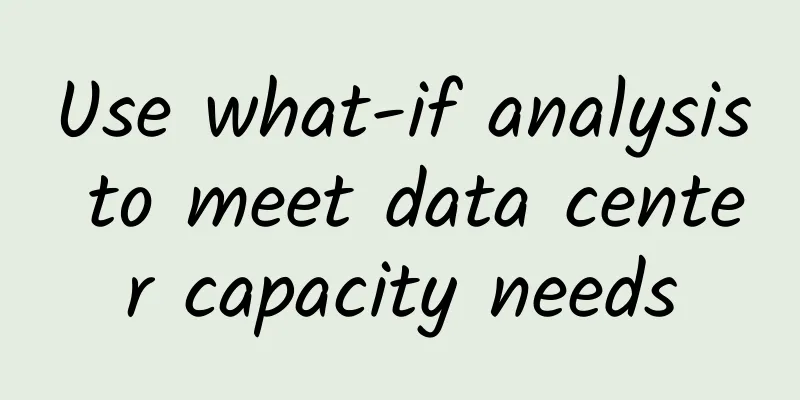Use what-if analysis to meet data center capacity needs

|
The authors describe the challenges of capacity requirements and planning for dynamic IT architectures and why what-if analysis is a critical tool for capacity management in modern data centers. Today, technologies such as big data, the Internet of Things (IoT), and artificial intelligence (AI) are booming, generating large amounts of data and enabling organizations to drive business innovation. However, they also consume a lot of IT resources. These emerging technologies require important basic computing and transaction support from data centers, and data center managers are struggling to keep up with demand. How can modern data center managers respond with agility and flexibility to meet growing demands? The answer lies in dynamic, scalable provisioning and the ability to efficiently manage computing resources at the speed of IT.
Common barriers to planning effective capacity The data center is a massive system of interconnected devices, in some cases exceeding a million pieces of equipment from hundreds of vendors. Colocation facilities, data center migrations, and cloud computing/hybrid environments have further complicated an industry that was previously dominated by enterprise data centers. Therefore, configuration efforts must take into account the complexity of today's data centers. However, many data center managers are struggling to understand the real-time capacity of power, space, cooling, network connections, power connections, and power loads at the data center level through UPS, control panels, iPDUs, and ports. So how do you know what equipment is there and where each device is located? How is it configured and connected? Most importantly, does the organization have enough space, power, cooling, and network capacity to provide new equipment for the business? Understanding the correlations between these physical elements is critical to understanding potential shortages in data center resources. However, managing the complexity of data center capacity planning is difficult, inefficient, and unreliable with traditional spreadsheets and CAD drawing programs. That’s why so many organizations are adopting data center business intelligence software and dashboards to analyze, simplify, and accelerate capacity demand planning. What-If Analysis: Beyond Generic Metrics Understanding metrics such as floor space remaining, cabinets with the most open data and power ports, and budgeted power are solid starting points for capacity management. Capacity forecast graphs with historical trends can help create a clearer picture. However, to fully utilize existing capacity and purchase more if necessary, organizations need more advanced analytics. That’s where what-if scenarios come in. When used as part of a data center infrastructure management (DCIM) software solution, what-if analysis allows organizations to understand the potential impact of changes in the data center, especially when adding and removing capacity, so they can quickly and accurately predict the future state and determine whether adding additional resources can be postponed or if more resources need to be purchased. The simplest and most useful approach is to look at scenarios related to capacity on a per-project basis. For example, as a data center manager, you may have multiple concurrent projects in the pipeline. You may have several consolidation projects, projects to retire assets, and new projects for which you need to reserve resources. What-if analysis allows managers to see the net effects and tradeoffs for individual or groups of projects so that they can:
What-if scenarios can take your capacity planning to the next level, enabling provisioning at the speed of IT while also providing justification for spending to your management team. How DCIM helps organizations meet their IT needs What-if analysis is often just one component of a comprehensive DCIM solution that can help organizations quickly provision and plan capacity. Organizations also need to deploy power meters for iPDU and UPS metering, distribution circuits, feeder circuits, and various sensors for temperature, humidity, airflow, pressure, etc. deployed throughout the data center environment. Once the necessary instruments and meters are deployed, the organization's DCIM software can collect and analyze data to easily view the capacity level of each component of the data center and determine where resources are over-provisioned, wasted or under-provisioned resources, potential risks, etc. Over time, predictive analysis and what-if analysis help organizations plan infrastructure deployment in a timely manner to support the launch of dynamic IT architectures, applications and services. Putting it all together While the metrics most commonly used to plan data center capacity are helpful, they are not enough to provide a complete picture of future capacity needs. What-if scenarios can bridge this gap by processing as well as supplementing so that organizations can accurately determine whether capital expenditures for new resources are needed. In addition, what-if analysis charts enable data center staff and their management to view the same data and understand at a glance the rationale for data center capacity plans. With what-if analysis, organizations can quickly gain the insights they need to quickly configure and manage the needs of dynamic IT architectures. When what-if analysis is used with DCIM software that collects and analyzes instrument data through smart devices and sensors in the data center, it allows organizations to more accurately plan capacity and reduce waste, thereby maximizing productivity and improving customer satisfaction and the ability of management teams. |
<<: Why haven’t white box vendors penetrated the large enterprise market? How can they change that?
>>: The basics of optical fiber you must know
Recommend
Wang Chunhui: 5G releases three major functions to drive China on the path of high-quality development
On June 6, 2019, the Ministry of Industry and Inf...
South Korea's 5G penetration rate exceeds 20%, and 2G networks are about to be completely shut down
South Korea's Ministry of Information and Com...
10gbiz VPS 60% off, Hong Kong CN2 GIA line from $2.75/month, Los Angeles CN2 line from $2.99/month
10gbiz is a foreign hosting service provider foun...
6G research should be prepared for a rainy day
Since 5G is still in the development and deployme...
Beware of online scams and cyber attacks during the World Cup! F5 ensures application security, allowing fans to watch the game with peace of mind
It is well known that the holiday shopping period...
Three wireless LAN positioning technologies: Wi-Fi, Bluetooth and UWB
In the context of the Internet of Everything, the...
The development of 5G will open up a new track for the Internet of Things
The Ministry of Industry and Information Technolo...
How many devices can a wireless AP and a wireless bridge carry? One article to find out
Many friends asked me, what is the capacity of a ...
The speed can reach 10,000 times that of 5G, and the official interpretation of 6G is here
In the era of mobile Internet, whoever has more a...
Lingyan Technology: Brand new debut and comprehensive strategic upgrade
Over the past century, as the country has become ...
Good news for 5G: the rate is no higher than 4G, and you don’t need to change your phone number when you change your phone
Large bandwidth, large connections, low latency a...
RAKsmart: US servers start from $20/month for the first month, Japan/Korea servers start from $59/month, cluster servers start from $109/month
RAKsmart is carrying out the "New Year's...
Microsoft blocks IE10 and other older browsers from accessing official websites
Although you may have bought the genuine version ...
Japanese media: China may be the first to master 5G international standards
China, which has no say in almost all modern scie...
If these five gaps cannot be overcome, 5G 2B will be a pipe dream for operators
In the 5G race, Asian operators are among the wor...









